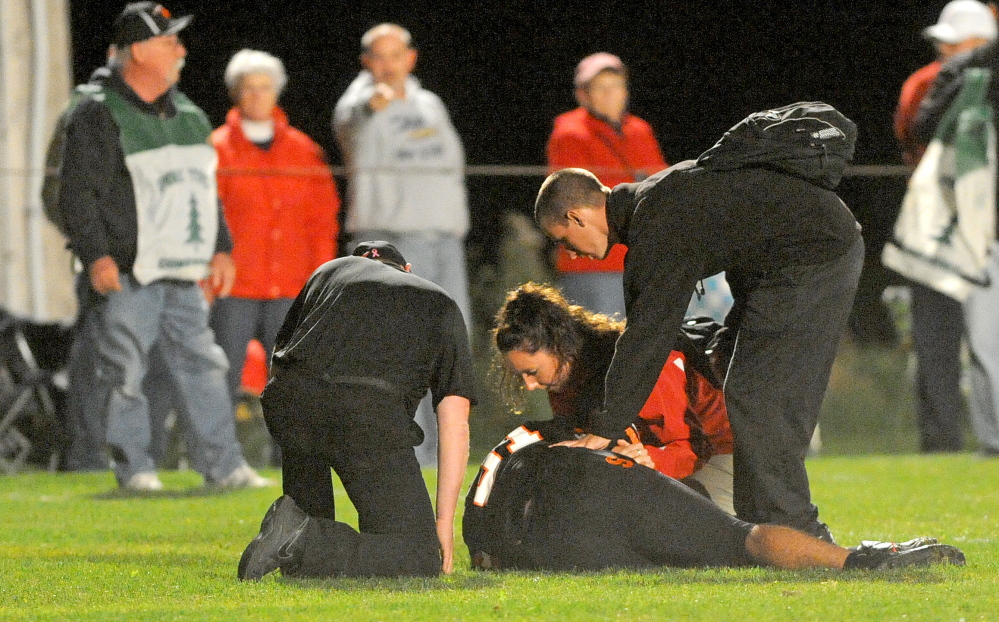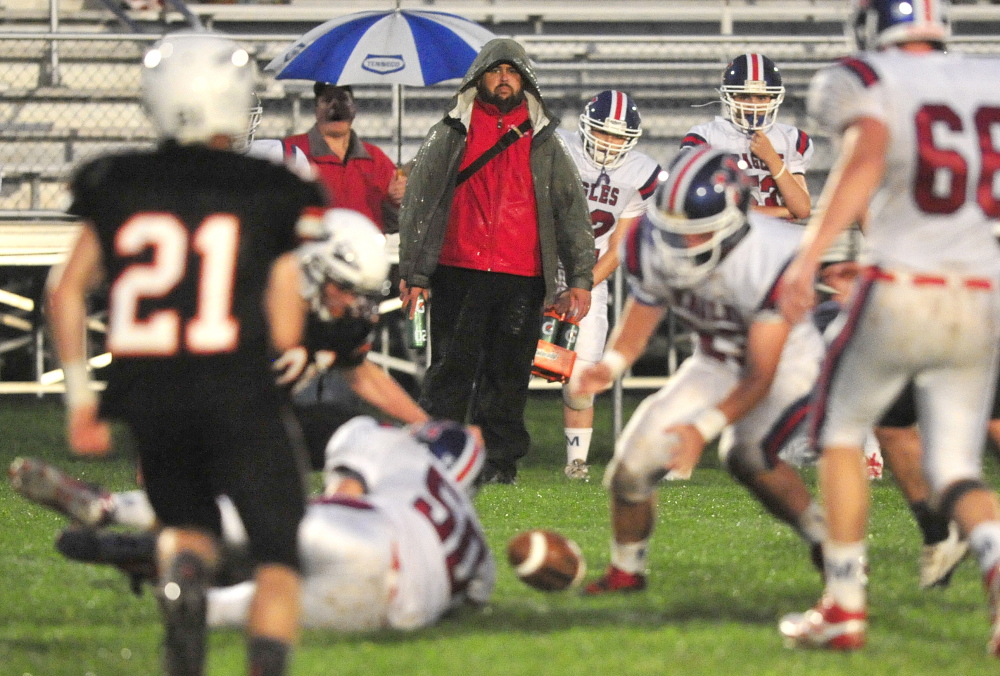The line of athletes at Cony High School forms when school lets out just after 1:45 p.m. Fifteen minutes later, it’s extended well down the corridor that leads to the trainer’s room. It includes boys and girls on the lacrosse, track, baseball, softball and tennis teams all waiting to be seen by Alycia Laferte, one of nine certified athletic trainers employed by MaineGeneral Sports Medicine.
She greets everyone with a smile and calls them by name. This is a typical day for Laferte, who attends to a couple of early birds before the onslaught begins.
She applies ice to a lacrosse player’s knee then tapes the ankle of another. These players receive priority treatment because they’re soon headed for the bus and an away game.
“When you come in here, it can be the smallest injury like a pulled muscle or a more serious injury like a concussion,” Cony senior Brandon Elwell said. “Alycia (will give) you several tests and she won’t stop until she figures out how to fix it.”
On an adjoining table Marshall McLaughlin is raving about Laferte’s ankle-taping ability. He doesn’t want to miss the day’s game, in part because it’s almost a certain win and many are expected to get into the scoring act. No so fast, Laferte says. First, McLaughlin will have to pass his agility test before he’s allowed to play.
If all Laferte did was apply ice bags and tape ankles she’d be providing a valuable service, but the athletic trainers at MaineGeneral do so much more. They’re part of a close-knit team that includes four physicians to whom they often refer the athletes. The trainers monitor their progress before and after surgery and are on the front line of rehabilitation.
“What they do for us is immeasurable,” Cony athletic director Paul Vachon said. “They’re in touch with the athletes, the parents, the teachers. It’s a resource we can’t do without.”
The scene at Cony is repeated at high schools throughout central Maine that come under the MaineGeneral umbrella. Waterville, Winslow, Messalonskee and Cony all have full-time trainers while Cony and Messalonskee also have a physician on site one day a week.
Schools receiving coverage also include Lawrence, Erskine, Monmouth, Gardiner, Hall-Dale, Richmond, Winthrop and Maranacook. Thomas College and Kents Hill are also under MaineGeneral care on an as-needed basis. So, too, are several junior high and middle schools. For the most part, athletic trainers are assigned to one or two schools and attend as many home athletic events as time allows. Often when one school has multiple events, trainers from other schools help out. Schools pay a fee but some of the cost is subsidized by MaineGeneral.
“MaineGeneral is so dedicated to the community,” said Chris Sementelli, manager of sports services and an on-site athletic trainer himself. “We can go after the schools and not charge a lot of money and in some cases do it for free. Not many hospitals can see the bigger picture.”
Although many other schools in Maine have athletic trainers, Sementelli said the MaineGeneral program is a one-of-a-kind operation because of the extent of the athletes it covers and the liaison with the medical staff.
“In our area it’s incredibly unique,” said Dr. Chris Lutrzykowski, a member of the sports medicine team. “The athletes get training services that a lot of D-3 (colleges) don’t get.”
Lutrzykowski volunteers his time once a week at Cony; Dr. James Dunlap does the same at Messalonskee. The two are primary care sports physicians who specialize in concussion management and non-operative orthopedics. Dr. Anthony Mancini and Dr. David Lemos are orthopedic surgeons who are part of the team and have operated on hundreds of central Maine athletes. Physician’s assistant Mark Wright is also part of the team.
Athletic trainers aren’t required to have a medical degree but they do need a four-year bachelor’s degree in their field and must have board certification to practice. Additionally, they must undergo 50 hours of continuing education every two years. In-state schools that provide four-year degrees for athletic trainers are the University of Maine, the University of Southern Maine, the University of New England and the University of Maine at Presque Isle.
Collision sports a priority
Collision sports take precedence over others when it comes to on-site athletic trainers; football heads the list.
“Football takes priority at Lawrence,” athletic trainer Steve Tosi said. “There are a lot of injuries in football. Soccer is pretty high, too.
Because there are three adjacent fields at Lawrence, Tosi is never far from reaching an athlete in any sport. Sometimes a decision has to be made when there is more than one injury at the same time, as often occurs in football.
“You’re on opposing sidelines,” Tosi said. “You have to triage. Who’s worse?”
Coaches are obligated to have first aid training and sometimes can attend to minor injuries. Many of the injuries involve knees, ankles, ribs and shoulders. Lacrosse and hockey are also sports that typically have athletic trainers on site. Generally, these are not life-and-death situations but there’s always that chance.
An athlete playing hockey at the former Kennebec Ice Arena in the mid 1990s had a major artery severed by a skate and was treated on the spot by an athletic trainer. And Sementelli had to revive an athlete who was unconscious at a basketball camp.
“Then the head injury is always looming,” Tosi said.
Treatment of concussions or potential concussions has come a long way in the past 20 years. No longer can a coach decide if an athlete can return from the sideline after he or she has displayed concussion-like symptoms.
“If you have a head injury and are showing signs of a concussion, you’re done,” Tosi said. “That’s a state law. The coaches know our word is the final say. You really have to be decisive with what’s going on with the athlete. The brain is something we have to protect.” Athletes who sustain concussions see Lutrzykowski or Dunlap before receiving clearance to play but they continue to be closely monitored and tested by athletic trainers after they resume athletic activity.
“I rely on those guys pretty heavily,” Lutrzykowski said. “They are essential to getting the athlete back to play.”
Getting back, but not too quickly
Sementelli said under-reporting and nonreporting injuries is still prevalent among athletes and it’s up to the athletic trainers sometimes to decide who’s hurt and who’s not. Their job is to get the athlete back on the court or the field as quickly and safely as possible. The vision of the old cigar chomping athletic trainer who sends an injured player back into the game at halftime is long gone.
“We’ve come a long way in 20 years,” Sementelli said. “Our training is the same as any physician gets as far as hands-on testing.”
Vachon recalled a time when he was preparing his Cony girls team for a state championship game against Westbrook in 1995 and his daughter Amy had a pulled hamstring. Sementelli doubted if she’d be ready to play.
“Amy pulled a hamstring on Monday,” Vachon said. “(Chris) worked with her all week to get her ready for the state game (and she played). We don’t win without her. That’s one I’ll never forget.”
One goal of athletic trainers is to keep athletes in the school and minimize costs. It’s working with the MaineGeneral team, and has for years.
“It keeps kids from bouncing into the ED (emergency department),” Lutrzykowski said.
Sementelli believes athletes are taking better care of themselves today and part of that credit goes to the sports medicine staff and preventative care in general.
“There’s been a big difference in how kids eat and how schools and coaches educate,” he said. “Their knowledge is better.”
At the same time there are pitfalls.
“I totally believe athletes are taking better care of themselves,” Sementelli said. “What’s worrisome is the overuse stuff, the commitment to one sport or activity. Anytime you specialize in one activity and repeat it over and over again, you’re only asking for problems.”
The key to MaineGeneral Sports Medicine’s success, Lutrzykowski said, is communication.
“All the trainers have ready access to my cell phone,” he said. “The other thing, we’re all in the same building. You can cross paths in the hallways.”
Lutrzykowski left the state for awhile but his decision to return was based on the success of the hospital’s sports medicine program, initiated by Sementelli, who’s been here 24 years.
“I don’t know if I would have come back to the area if it wasn’t for the system,” he said. “Chris has really spearheaded this over the years and made this work. It’s really his baby.”
Gary Hawkins — 621-5638ghawkins@centralmaine.comTwitter: @GaryHawkinsKJ
Send questions/comments to the editors.




Comments are no longer available on this story